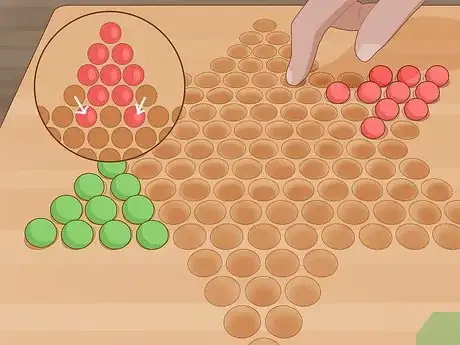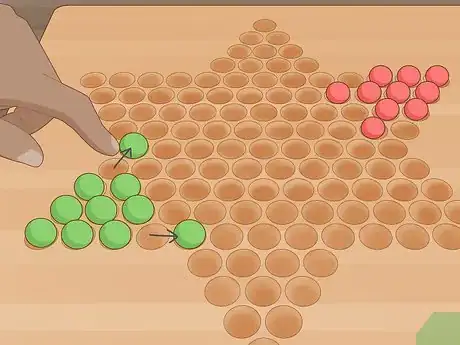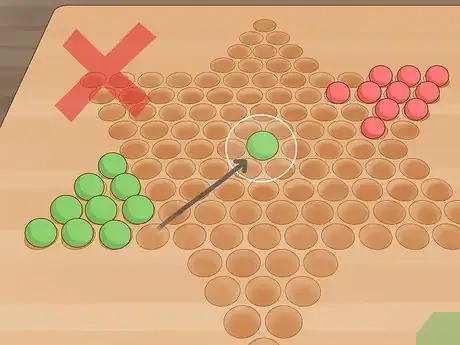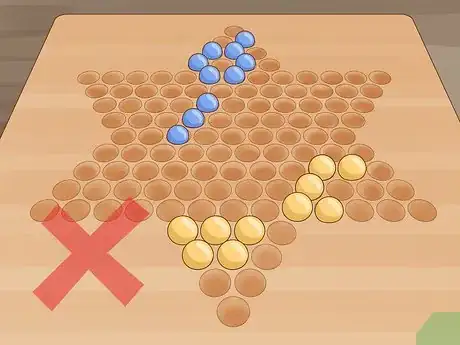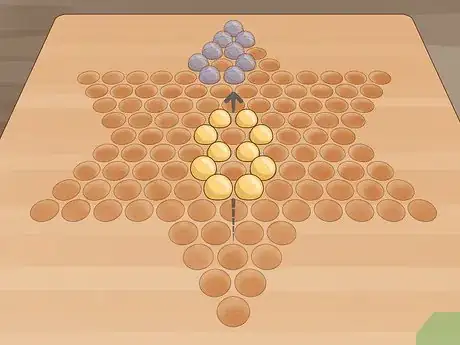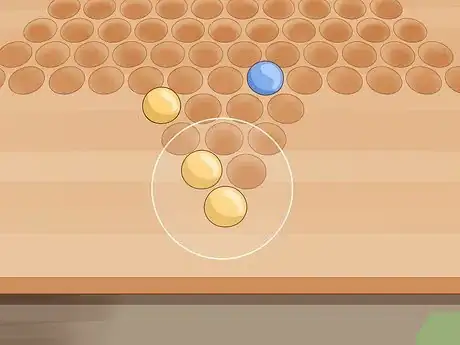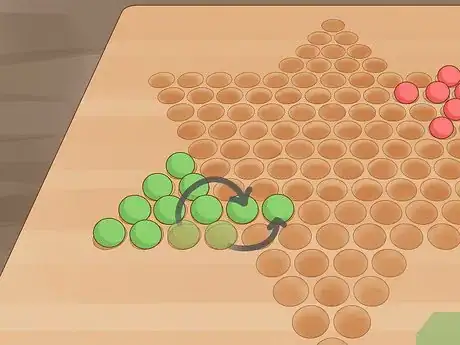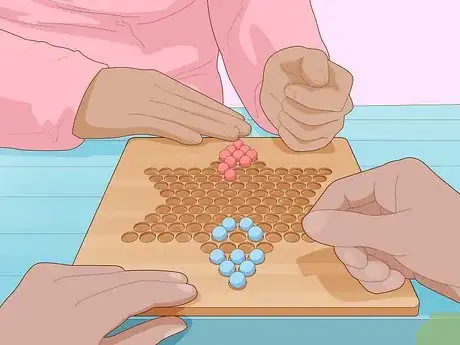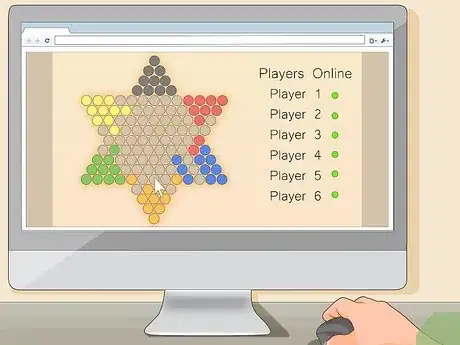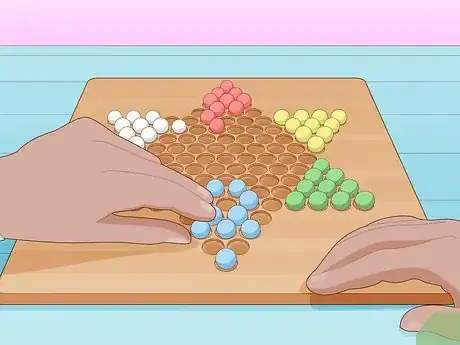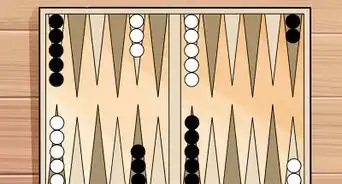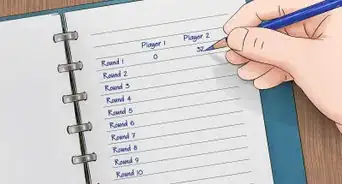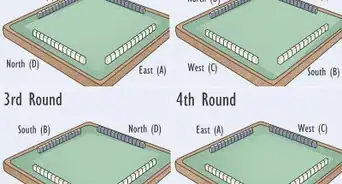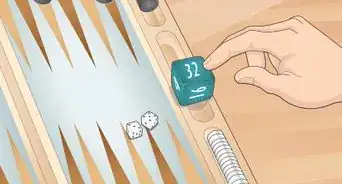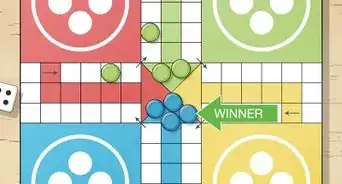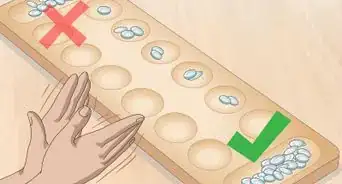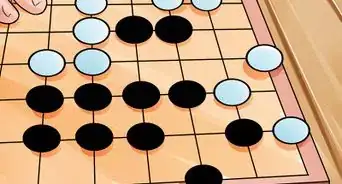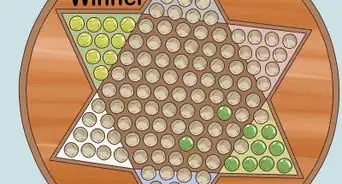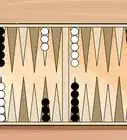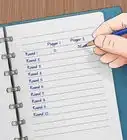wikiHow is a “wiki,” similar to Wikipedia, which means that many of our articles are co-written by multiple authors. To create this article, 20 people, some anonymous, worked to edit and improve it over time.
wikiHow marks an article as reader-approved once it receives enough positive feedback. In this case, 80% of readers who voted found the article helpful, earning it our reader-approved status.
This article has been viewed 251,318 times.
Learn more...
Chinese checkers is a relatively simple game, but that doesn't mean it's easy to win. Like any game, the more you play the better you'll get at it. However, it is also helpful to consider some basic and advanced strategies so that you have a leg up on your opponents.
Steps
Performing the Correct Opening Moves
-
1Move your two pieces inward. The Chinese checkerboard is shaped like a star. When the game starts, you have the option to move one of four pieces at the base of your point of the star. Move the piece all the way on the right forward and to the left. At your next move, move the piece all the way on the left forward and to the right. You should be left with the two pieces sitting right next to each other one step in front of all the rest of your pieces. [1]
- The idea behind starting inward is that you can make a direct route towards the center of the board. You also don’t want any lone wolf pieces, so keeping two pieces near one another is better than moving one forward alone.
-
2Move your first two pieces outward. One other common opening move is very similar to the inward opening move. Rather than moving your two pieces forward and closer to each other, move them forward and further away from each other. That means the piece all the way on the right will move up and to the right and the piece on the left will move up and to the left. This is a less common but still viable strategy. [2]
- Moving your pieces outward is a fine opening move too. It also sets you up for a route directly across the board while keeping your pieces close to other pieces.
Advertisement -
3Avoid using any other variation of opening move. If you watch really good Chinese checkers players you’ll notice that they always start with one of two opening moves – the two moves listed above. If you don’t start with one of these two moves you are immediately putting yourself at a strategic disadvantage.
Playing with Basic Strategy
-
1Set up your checkers correctly. The best way to get a few checkers out of your area is by moving the checker on the right or left of the triangle toward your opponent's checkers. Then, you use one of the second checkers from the corner of the triangle and hop it over the third and fifth checkers.
-
2Keep your pieces toward the center of the board. Similar to chess rules, if you keep your pieces away from the side they are less likely to become stranded. A great way to get pieces along the middle of the board is by setting up a zigzag line of your pieces. Then you can take the last piece in the line and hop over the other pieces. In Chinese checkers you can move forward by hopping over the pieces in front of your checker. So if you have one piece in the back and a zigzag of other pieces across the board, you can hop all the way down the line of your pieces.
-
3Avoid stragglers. You generally want to move your marbles as a group rather than having a lead scout marble or a marble stuck in the back. If you have a marble in front or stuck in the back it is unable to use your other marbles to travel forward. Similarly, if you have a marble way in front it is of no use to the marbles behind it. Marbles can hop on one another to travel forward but they have to be next to each other for this to work.
- Always look to jump your last marble forward so it doesn't get left behind. [3]
Utilizing Advanced Strategies
-
1Use a very direct route. [4] The goal is to fill the entire tip of your opponents star with your pieces before they do the same to you. Because speed is important, you want to move your pieces as directly through the center of the board as possible. This obviously depends on how your opponent moves, but you don’t want to be moving your pieces off into unused portions of the board.
- You may think you are keeping them safe, but in reality you’re just taking them out of the game and making it more difficult for yourself.
-
2Try a defensive strategy. [5] Some players utilize a stay at home strategy. This means keeping one checker in the very tip of your star so that your opponent can never completely fill up your star. Keep in mind that you will be unable to win this way, since eventually you will need to move it out in order to fill up your opponents star.
- Some consider this strategy unsportsmanlike.
-
3Anticipate your opponent. You are allowed to make as many jumps during a turn as you want. However, that's not always the best strategy. [6] Try to pay attention not just to your own tactics but also to what your opponent is trying to accomplish. Blocking your opponent is one of the biggest parts of Chinese checkers. Put yourself in your opponent’s shoes and imagine what the next best move would be. Now think of other possible good moves, and try to guess which one you think they will do.
- It might serve you well only to make a few jumps and then block your opponent from being able to move to the space that they wanted to. Constantly assess your opponent’s intentions.
-
4Move your pieces into every other row to fill up your goal area. This strategy is more efficient than working from the back to the front. You’ll be able to fill your goal area with fewer moves given that you can continue to hop over your own pieces. If you can occupy the goal area more quickly than your opponent then you’ll be more likely to win. [7]
Practicing
-
1Practice against friends. The more you play the more comfortable you’ll be with the game and the more intuition you’ll develop. It’s much easier to anticipate moves if you have seen them before. Play as much as possible.
-
2Play online against computers. [8] If you can’t find people to play with you can always play online. Many websites have free Chinese checkers available. Set the computer difficulty to a setting that is appropriate for your skill level.
-
3Play against yourself. This may seem silly, but if you are playing against yourself you’ll force yourself to think about the counters to every single move that you normally make.
- If you play against yourself, you’ll be aware of the ways that you can counter your opponent. You will also be aware of the ways that they can counter your favorite moves when you play for real.
Community Q&A
-
QuestionHow does a winning board look for two players?
 Community AnswerWhen someone has won, one color will be all arranged in a triangle on the opposite side of their start triangle, and the other color will probably be mostly assembled into a triangle but not quite there yet.
Community AnswerWhen someone has won, one color will be all arranged in a triangle on the opposite side of their start triangle, and the other color will probably be mostly assembled into a triangle but not quite there yet. -
QuestionCan I move sidewards?
 Community AnswerYou can move in any direction, as long as you don't return to one of your starting points.
Community AnswerYou can move in any direction, as long as you don't return to one of your starting points. -
QuestionHow do I arrange a triangle at the end of the game of Chinese checkers?
 Community AnswerLike what was explained in the above strategies, it can be helpful to have the row of two occupied first and the row of four occupied second, so that one of the remaining four marbles can hop to the point or peak tile of the goal triangle. Then the last three can hop in to fill up the row of three, for the win.
Community AnswerLike what was explained in the above strategies, it can be helpful to have the row of two occupied first and the row of four occupied second, so that one of the remaining four marbles can hop to the point or peak tile of the goal triangle. Then the last three can hop in to fill up the row of three, for the win.
References
- ↑ http://www.memory-improvement-tips.com/chinese-checkers-strategy.html
- ↑ http://www.memory-improvement-tips.com/chinese-checkers-strategy.html
- ↑ http://www.learnplaywin.net/chinese-checkers LearnPlayWin Chinese Checkers Guide
- ↑ http://www.memory-improvement-tips.com/chinese-checkers-strategy.html
- ↑ http://www.learnplaywin.net/chinese-checkers/chinese-checkers-tips.htm
- ↑ http://www.learnplaywin.net/chinese-checkers/chinese-checkers-tips.htm
- ↑ http://www.learnplaywin.net/chinese-checkers/chinese-checkers-tips.htm
- ↑ http://www.learnplaywin.net/chinese-checkers/chinese-checkers-tips.htm
About This Article
To win at Chinese checkers, move your checkers from your triangle into the triangle directly across from you before your opponent can move all of their checkers. Try to move your pieces in a group, and keep your pieces in the middle of the board so it won’t take as many moves to get them to the other star. When it’s your turn to move, look for opportunities to jump your last checker over other pieces on the board to move it forward quickly. For tips on making the right opening move, keep reading!
